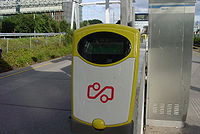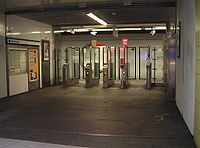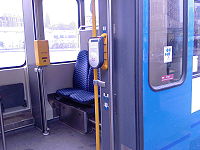- OV Chip Card
-
The OV-chipkaart is a contactless smart card system which is in the process of being introduced on all public transport in the Netherlands, including train, metro, tram and bus. It allows the combination of card integration (the same card is used for multiple transport companies) and price differentiation (by company, time of day, day of the week, etc.), and is intended to reduce fare dodging. The OV Chip Card replaced the strippenkaart completely on 3 November 2011.
The full name in Dutch is Openbaar Vervoer chipkaart (public transport chip card).
The OV-chipkaart is a cooperative initiative of five large public-transport operators: NS (railways), Connexxion (buses), RET (Rotterdam), GVB (Amsterdam), and HTM (The Hague). These five companies established the joint venture Trans Link Systems (TLS) to implement the OV-chipkaart. However, all other public transport companies will eventually have to implement the system as well.
In April 2007, the OV-chipkaart received an award in the Transportation category of the Computerworld Honors Program Laureate.[1]
For public transport other than trains, the OV-chipkaart has been the only system valid in the Rotterdam and Amsterdam regions since mid-2010, and in most of the rest of the country since 7 July 2011.[2] It will also eventually replace paper rail tickets. For rail journeys involving multiple operators, paper tickets remain cheaper, but there are rail passes for free or discounted off-peak travel which are only available using the OV-chipkaart.
Contents
Types of cards
Three versions of OV-chipkaart are available: the disposable OV-chipkaart, the anonymous OV-chipkaart, and the personal OV-chipkaart.
Disposable OV-chipkaart
The disposable OV-chipkaart is made of stiff paper and thrown away after use. It can only be used for travel products and does not feature an electronic purse. It is intended for people who rarely use public transport in the Netherlands, and tourists. It is available for a range of fares, from a short single journey to a three-day pass, and is considerably more expensive than the permanent cards.
Anonymous OV-chipkaart
The anonymous OV-chipkaart is a permanent card for people who travel more frequently, but who are not entitled to any discounts. It is reusable and features an electronic purse. It is transferable, and therefore cannot be used for discounted travel, or for monthly or annual season tickets. However, the anonymous card can contain multiple products simultaneously.
Personal OV-chipkaart
The personal OV-chipkaart is useful for anyone entitled to travel with a discount (for example children aged 4–11, students, senior citizens and holders of discount cards). It is also the only type that can hold a monthly or annual season ticket. The personal card is non-transferable and features the holder's photograph and date of birth. It includes an electronic purse. In addition, it can be set to top its balance up automatically when it drops below 5 euros. The personal card is the only one which can be blocked if it is lost or stolen. The personal OV-chipkaart is currently only available to Dutch bank-account holders.
Travelling with the OV-chipkaart
Paying for a trip
There are two ways to pay for travel using the OV-chipkaart:
Travellers can buy a travel product, for example a one-day pass for an entire city or a monthly season ticket for a certain route. When they check out after the trip (see next section), the system will recognise that a certain product has been used and, if necessary, deactivate it.
The other option is to use money from the electronic purse on the OV-chipkaart. At check-in, the system charges a checking-in fee, ranging from 4 to 20 euro, depending on the type of transport and the discount. This in then refunded when the traveller checks out, minus the fare for the trip actually made. If a user fails to check out the difference, which is higher than the fares for most of the possible journeys, is not refunded. If all card readers are out of order, the traveller can claim the checking-in fee back from the travel authority. If a traveller fails to check out too many times the card is blocked and cannot be used again, even if there is a valid product on it.
During a trip, travel staff can check cards using a mobile reader. One must travel away from the point where one checked in.
Checking in and out: train or metro
For journeys by train or metro, the traveller checks in by holding the OV-chipkaart up to a reader on reaching the platform. The checking-in fee is debited. When leaving a station, the passenger checks out by holding the card up to the reader and the checking-in fee is refunded, minus the fare for the journey actually made (where appropriate).
There are two types of card-reader systems on train and metro stations: free-standing card readers, and card readers integrated into ticket gates. To prevent fare dodging, gates are used wherever possible, for example in underground or elevated stations, where travellers cannot access the platforms without going through the gates. Stations at ground level generally have free-standing card readers. Gates were considered too dangerous at ground-level stations, since they would encourage fare-dodgers to bypass them and access the platforms by walking on the rails. However, this still happens, for example at Rotterdam Alexander.
Checking in and out: tram or bus
When travelling by tram or bus, travellers check in and out when entering or leaving the vehicle, using card readers located by the doors. Passengers usually board buses and trams by the door nearest to the driver or conductor, who keeps an eye on them checking in. The driver or conductor cannot so easily monitor passengers disembarking. A passenger who fails to check out on exit will pay too much for the journey, since the excess portion of the check-in fee is not refunded. In addition, passengers can dodge part of their fare by checking out long before the end of their journey. For this reason, random fare checks will continue to operate.
Technology
The OV-chipkaart is based on Philips (currently NXP Semiconductors) Mifare technology. The anonymous and personal cards are Mifare Classic 4K cards with about 4 kilobytes of storage. They are read/write protected by keys known only to the vendors. The disposable passes are cheaper Mifare Ultralight cards that do not employ any encryption or keys, and can be read by anyone. The Mifare encryption algorithm (known as Crypto-1) is believed to have been cracked.[3] Even so, the transport corporations are continuing with the introduction of the OV-chipkaart, since the security of the system does not rely on the encryption of the tickets. Once the complete security system is in place, the authorities claim they will be able to detect fraudulent cards (cloned cards, or changed content, e.g. a not-warranted e-purse reload) and blacklist suspect cards.[4] However recent developments have shown that it is now relatively easy to hack the cards.[5] At first, an extensive knowledge of the Linux-based Operating System was required in order to read or alter data on the OV-Chipkaart. Recently[when?], however, programs have surfaced for Windows that only require a Mifare card reader to add credit to the card. And it has also been proved that cards can be hacked in ways invisible to Trans Link Systems. This is done by checking the card in at home with the hacking software, which in turn means that TLS will not see that the card is being used. The current card-checking technology also fails to reveal fraudulent check-ins on board.[6][7][8] Even though the release of these programs mean that anyone with the program and a card reader/writer can travel for free without being caught, the Ministry of Infrastructure and the Environment is continuing the roll-out of the OV-Chipkaart, but has announced that TLS will start producing cards with the more fraud-resistant SmartMX chip. However, it may take up to six years for the new cards to replace the old ones.
The technology is not faultless. Upon checking out, the card readers display the amount deducted and the remaining balance. It is not uncommon for the wrong amount to be deducted: a sample of journeys in 2011 which bear a €1.09 fare has resulted in changes of €0.77, €1.53 and €2.37. Passengers who notice these errors can claim a refund via the relevant operator's website, quoting a Dutch bank account number. However experience shows that operators do not necessarily refund overcharges.
Rollout
The OV-chipkaart was first introduced in the Rotterdam metro, in April 2005. In 2006, the programme was expanded to include all Amsterdam metro and rapid-tram (Sneltram) lines (50, 51, 53, 54). All trams and buses in Rotterdam accepted the OV-chipkaart from June 2007, and in November 2008 this was extended to all trams and buses in Amsterdam.
Until 29 January 2009, traditional fare-collection systems were still in place everywhere, alongside the OV-chipkaart. Thereafter, the strippenkaart ceased to be valid in the Rotterdam metro, leaving the OV-chipkaart as the only option. The Amsterdam metro withdrew the strippenkaart on 27 August 2009. On 11 February 2010, the Rotterdam region withdrew the strippenkaart completely. The Amsterdam region followed suit on 3 June 2010. The province of South Holland (including The Hague) withdrew the strippenkaart on 19 May 2011. The strippenkaart ceased to be valid anywhere on 3 November 2011.
At the time of writing (August 2011), the OV-chipkaart can be used in the whole of the Netherlands, except for some of the Frisian islands and some regional rail operators.[9][10]
For the national rail carrier NS, the system has been operational for full-fare travel since October 2009, and for discounted fares since December 2009. There are plans to introduce the OV-chipkaart for other forms of travel as well (e.g. monthly or annual passes).
See also
References
- ^ "The Computerworld Honors Program: Trans Link Systems smart card (OV-chipkaart)". http://www.cwhonors.org/viewCaseStudy.asp?NominationID=258.
- ^ "Travel area OV-chipkaart" (in Dutch). http://www.ov-chipkaart.nl/allesoverdeov-chipkaart/waarreizen/waartegebruiken/.
- ^ "Mifare — Little Security, Despite Obscurity". 24th Chaos Communication Congress. http://events.ccc.de/congress/2007/Fahrplan/events/2378.en.html. Retrieved 2008-01-14.
- ^ "Invoering OV-chipkaart gaat verder" (in Dutch). NOS Teletekst. NOS. 2008-02-29. http://www.nos.nl/nos/artikelen/2008/02/art000001C87AC141B6C7A6.html. Retrieved 2008-02-29.[dead link]
- ^ "OV Chipkraak nu voor elke Windows gebruiker" (in Dutch). http://webwereld.nl/nieuws/105494/ov-chipkraak-nu-voor-elke-windows-gebruiker.html#utm_source=article_related_news_1&utm_medium=website&utm_campaign=ww.
- ^ "Hacktools ov chipkaart gelekt op internet" (in Dutch). http://webwereld.nl/nieuws/105511/hacktools-ov-chipkaart-gelekt-op-internet.html.
- ^ "Een Paar Kliks En Je Reist Vogelvrij" (in Dutch). http://webwereld.nl/nieuws/105503/een-paar-kliks-en-je-reist-vogelvrij.html#utm_source=article_related_news_5&utm_medium=website&utm_campaign=ww.
- ^ "Minister onthult nieuwe hack maar OV chipkaart blijft" (in Dutch). http://webwereld.nl/nieuws/105529/minister-onthult-nieuwe-hack--maar-ov-chipkaart-blijft.html.
- ^ "Waar kunt u met de OV-chipkaart reizen?" (in Dutch). ov-chipkaart.nl. https://www.ov-chipkaart.nl/allesoverdeov-chipkaart/waarreizen/waartegebruiken/.
- ^ "Arriva OV-chipkaart reisgebied" (in Dutch). ov-chipkaart.nl. 2010-08-23. http://www.arriva.nl/ov-chipkaart/waar-werkt-de-ov-chipkaart/.
External links
- (English) OV-chipkaart.nl
- (English) Translink.nl, Trans Link Systems homepage
- (English) 24oranges.nl, Problems with OV-chipkaart
Categories:- Transport in the Netherlands
- Contactless smart cards
- Fare collection systems
Wikimedia Foundation. 2010.




